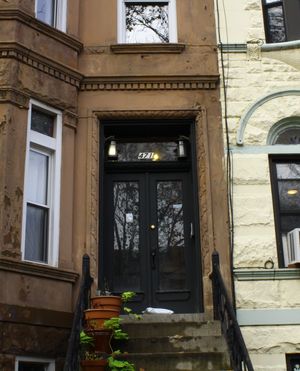Meet the Residents of MacDonough Street
Two musicians make the block their home.

“You look at what the houses are going for now in this neighborhood, and it just seems like a joke.”
—John-Paul NorpothTap to see price history of home
Jannina Norpoth, 33, and John-Paul Norpoth, 35Current Owners, Musicians
Jannina: We used to live in Washington Heights, but we were priced out of there. This was actually the very first thing that we looked at. Actually, I didn’t even see it; he looked at it with his family.
John-Paul: It was a Corcoran listing, which, at that time, struck me as atypical for this neighborhood. Now it’s common. I remember the open house we came to: You saw all different walks of life. The market was just starting to recover. So this was more or less the fallout from the housing crisis, leveraged debt, and a short sell. In hindsight, you look at what the houses are going for now in this neighborhood, and it just seems like a joke.
Jannina: You live in a Manhattan apartment, and you don’t even know who your neighbors are. Here, it was like people introduce themselves, they say hello. It’s almost like everybody knows everybody’s business on this block. We just moved here because it’s a beautiful place that we could afford, and it fit our needs. And we didn’t try to change anything about the block one way or another.
John-Paul: It all has to do with our ability, or our attitude, living in somebody else’s neighborhood. There just has to be a certain attitude about how you’re going to approach your neighbors, and how you’re going to talk to people. Because they’re looking out for your home, and you have to look out for their home.
Jannina: The change in the last four years has been huge. The cool thing — at least right now — is that most of the businesses that are opening around here are independently owned, so there’s a certain uniqueness. It’s great to be on a first-name basis with the guy who owns my grocery store. There’s a community that I never expected to have in New York City. Milton says he grew up in this house.
John-Paul: We met Milton the night we moved in.
Jannina: We have this upright piano. We couldn’t get it up the stairs by ourselves. So we had to just leave it in the front yard. We moved in at two in the morning because it took us longer than we thought. I heard people gossiping the next morning, “Yeah, they just moved in in the middle of the night, and they just left this piano sitting in their yard.”
Richard Buery, 44, and Deborah Archer, 43Former Owners, Deputy Mayor Under Bill de Blasio; Law Professor
Lives in: Moved in 2005 to New Rochelle. In 2014, returned to Brooklyn, renting in Park Slope.
History: Bought the house in 2001 for $306,000, renovated and restored it, and sold it four years later for $875,000.
Richard: Fort Greene was beyond our means. My wife and I are both nonprofit social-justice folks.
Deborah: Someone told us at the last minute there was this house that was vacant, and we went to see it that night like two hours before the bids were due.
Richard: We did not have children yet, but we wanted to have children, and trying to find a place that was safe, that was affordable, that was accessible … a lot of places were in rough shape. I remember walking through the house with flashlights. It had been abandoned for a while, the house had been cut up into multiple SROs and apartments. Some of the original details were there, but some had been pulled out. Neighbors would tell us, “Oh, yeah, I have your original mantelpiece because the people who owned it before had sold off pieces of the house.”
Deborah: We had a vision of what it would look like living in Bed-Stuy. We had a vision of the block we would live on. We had a vision of the house we would live in. And that house was perfect, although when you first saw it, it wasn’t a perfect house—the door was boarded up, the windows were boarded up. And with a lot of love, it became that house. And then when we sold it, it was in the on-the-market section of the New York Times, which was my husband’s dream because he read that every weekend. So it really felt nice to put in the work to live in the house that we had dreamed of, but also to put in the work in the house to help that community, to make sure that those beautiful historic homes remained.
Richard: I remember my father-in-law coming and looking at the abandoned house, and I’m pretty sure he thought I was crazy.
Deborah: We had a baby, and my Connecticut upbringing kicked in. I was sad to leave. I’m still sad. For a long time, whenever we were in the neighborhood, we’d drive by that house. When we sold the house, our neighbors were really fascinated by the process and what we were asking. It was a much higher amount than many houses were going for on the block a few years before that. They talked directly to us, like, That’s a lot of money. It did help them recognize that the community was changing. I think they were concerned that if there were buyers willing to pay those prices in Bed-Stuy, “Where would I go? And what could I afford?” And it made some of them more resolved that they were going to stay in the house they grew up in.